#2 May 1918
Photo

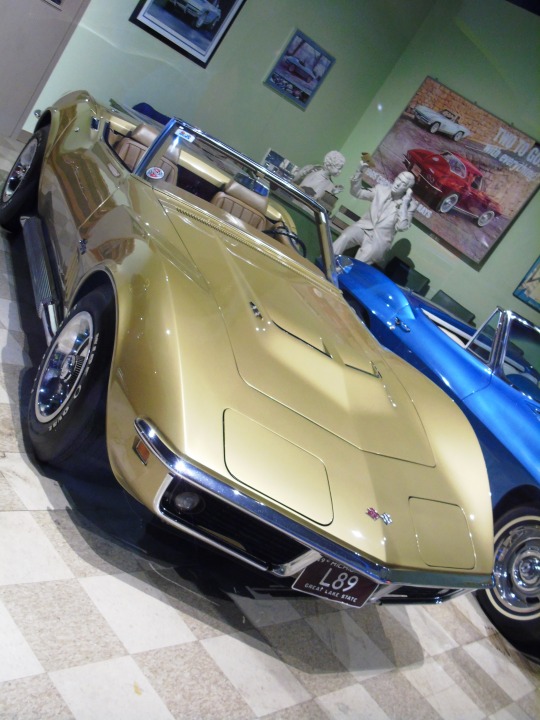








General Motors acquired the Chevrolet Motor Company of Delaware on May 2, 1918.
#Chevrolet Tahoe#Chevrolet Suburban#Chevrolet Corvette#GMC Yukon#Chevy#Chevrolet Impala#Chevrolet Nova#original photography#travel#USA#Torrington Cruise Night#Wyoming#rental car#General Motors#acquired#Chevrolet Motor Company#2 May 1918#105th anniversary#US history#B & K Root Beer Stand#tourist attraction#engineering#vacation#summer 2019#2022#Van Wert#Dinosaur National Monument#Utah#South Lake Tahoe#Nevada
5 notes
·
View notes
Text














BOBSTROLOGY
A completely serious presentation by @pegasusdrawnchariots and oatflatwhite
written version under the cut!
♈️Patrick O’Keefe [April 3 1926]
♈️Robert Sink [April 3 1905]
♈️John Julian [5 April 1924]
♈️Renée Lemaire [10 April 1914]
♈️James Miller [11 April 1924]
♈️Walter “Smokey” Gordon [April 15 1920]
♉️~Ronald Speirs [April 20 1920]
♉️Alton More [April 22 1920]
♉️Henry Jones [27 April 1924]
♉️Edward “Babe” Heffron [May 16 1923]
♉️John Martin [May 12 1922]
♉️Joseph Liebgott [May 17 1915]
♉️Norman Dike [May 19 1918]
♉️William Guarnere [April 28 1923]
♊️David Webster [June 2 1922]
♊️George Luz [June 17 1921]
♊️Roy Cobb [June 18 1914]
♋️Frederick “Moose” Heyliger [June 23 1916]
♋️Albert Blithe [June 25 1923]
♋️Donald Hoobler [28 June 1922]
♋️Thomas Meehan [8 July 1921]
♋️John Janovec [9 July 1925]
♋️Robert “Popeye” Wynn [July 10 1921]
♋️James "Moe" Alley [July 20 1922]
♌️~Burton “Pat” Christenson [July 23 1922]
♌️Eugene Jackson [29 July 1922]
♌️Donald Malarkey [July 31 1921]
♌️Edward Tipper [3 August 1921]
♍️Floyd Talbert [August 26 1923]
♍️Alex Penkala [August 30 1922]
♍️William Dukeman [3 September 1921]
♎️Eugene Roe [October 17 1922]
♎️Harry Welsh [September 27 1918]
♎️Lewis Nixon [September 30 1918]
♎️Ralph Spina [October 5 1919]
♎️Thomas Peacock [October 9 1923]
♏️Denver “Bull” Randleman [November 20 1920]
♑️Lynn “Buck” Compton [December 31 1921]
♑️Antonio Garcia [January 17 1925]
♒️Richard "Dick" Winters [January 21 1918]
♒️Herbert Sobel [January 26 1912]
♒️Carwood Lipton [January 30 1920]
♒️Warren “Skip” Muck [January 31 1922]
♓️Lester Hashey [23 February 1925]
♓️Charles “Chuck” Grant [1 March 1922]
♓️Robert Strayer [March 2 1912]
♓️Wayne “Skinny” Sisk [March 4 1922]
♓️Frank Perconte [March 10 1917]
♓️Darrell “Shifty” Powers [March 13 1923]
♓️Joseph Toye [March 14 1919]
6 Aries 🥉
8 Taurus 🥇
3 Gemini
7 Cancer 🥈
4 Leo
3 Virgo
5 Libra
1 Scorpio
0 Sagittarius 🥄
2 Capricorn
4 Aquarius
7 Pisces 🥈
10 🔥
13 🪨
12 💨
15 💧
20 cardinal
17 fixed
13 mutable
22 masculine
28 feminine
#band of brothers#hbo war#bobedit#hbowaredit#bobstrology#astrology#liz makes things#disclaimer: our interpretation is ironclad. we alone decide the law. argue w the wall.#< we say as an aries and scorpio with renee and bull in our corners <3
192 notes
·
View notes
Note
Hey babe, wanna hear something hot? *whispers* history of metformin

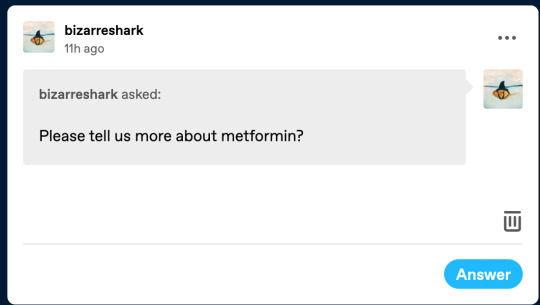
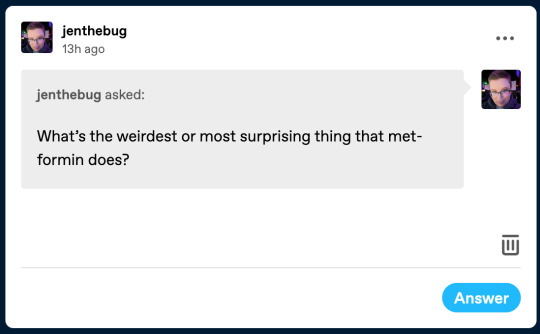


Ok okay I'll talk
So metformin is commonly thought of as the most boring of diabetes drugs. Like, everyone who has ever thought about maybe having type 2 diabetes is taking it unless it gives them diarrhea, and even then their doctor still probably wants them to take it. But it's a first line because it's old, it's cheap, it doesn't often cause hypoglycemia, and it has relatively few side effects compared to other diabetes drugs. Also, like a lot of older drugs, it does way more than it says on the packaging. And a lot of stuff we're still learning about.
In order to talk about metformin, we have to talk about a plant called goat's rue. Goat's rue is a plant native to Europe, Africa, and Asia, and currently grows just about everywhere. In ancient times it was used as an anti-parasitic, a plague remedy, and to relieve the excessive urination caused by what might have been diabetes. In 1918 it was found to contain a chemical called galegine, which did lower blood sugar. Galegine as an anti-diabetes medication is probably too toxic to use long term. However, with a few chemical tweaks, it could become a drug that lowered blood sugar without the toxic effects. Metformin was born.
Metformin came out in 1923 and is a type of drug called a biguanide. it's actually the only type in it's class still available as an anti-diabetic agent, because the other drugs in it's class that came out in the 1920s and 30s caused lactic acidosis and liver problems (similar to the types of reactions seen with galegine), and were taken off the market.
Metformin (and pretty much all oral antidiabetic agents in development at this time) didn't do well initially, probably because they came out the same decade as insulin, and insulin was a lot more effective at treating any kind of diabetes.
It fell out of use extremely quickly, and didn't get picked up again until the 1940s, when US access to antimalarial drugs was cut off, just as a war in the pacific was ramping up. Metformin was evaluated as an antimalarial during WWII, and while noted to have some anti-malarial properties (particularly as a malaria preventative) it also was noted to significantly lower blood sugar in diabetic patients- while not lowering blood sugar very much at all in non-diabetic patients.
This effect, rather than it's antimalarial properties, was what got scientists really interested. Unfortunately, it would not be until 1957 in France that metformin had its first major studies to determine that it did, indeed, work against diabetes. Metformin lost the race to the "first" (successful) oral antidiabetic agent by a year, to a different drug that was found while looking for a new antibiotic- Diabenese.
Metformin became a commercial success in France, while Diabenese became successful in the United States. Metformin would actually not be approved for use in the US until 1995.
But now we get to talk about what metformin does and why it's so freaking cool.
Type 2 Diabetes- lowers A1C (a measure of blood sugar control) by 1-2 full points
Prevents/reverses weight gain due to antipsychotics
Prevents and treats malaria
Makes the flu shot work better
Decreases severity of respiratory illness and complications related to the flu
Changes gut microbiome for the better
Regulates periods and reduces other symptoms in people with PCOS
Lowers risk of breast, colon, and prostate cancer
Lowers risk of dementia
Lowers risk of stroke
May increase lifespan
122 notes
·
View notes
Text






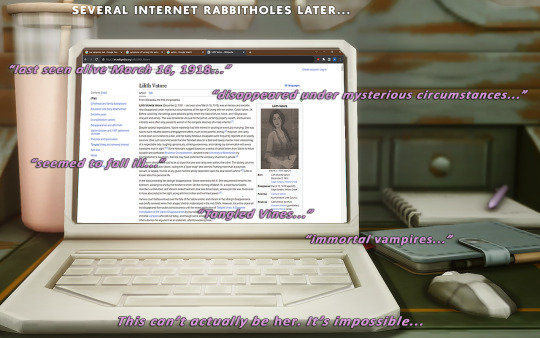
That moment you find out the girl you’ve been seeing is famous - for being a 130-year-old missing persons case with an entire "theories and speculation" section on Wikipedia.
Previous / Next
Yes, I made Lilith a Wikipedia page because I'm just that extra. If you want to read it (I threw in some new information), you can find the whole thing following the transcript below the cut.
Real-time footage of Helena researching:

[Snippets of Caleb's letter echo in Helena's mind] I will put it to you bluntly: Lilith and I have been vampires for some 100 years. Faced with your otherwise certain demise, I chose to make you one too. You may not believe me. It will feel like a bad flu for a day or two; then it will feel like the heat of 1000 fires blazing inside. I very well knew it would turn you into a monster against your will.
Helena, thinking: It's just a hangover, Helena. It's just a hangover. Yeah, that crazy bitch bit you, and her crazy brother wrote a dumb letter to scare the shit out of you. But vampires aren't real.
Thank god Ulrike left all these fucking tarps. This sunlight is murder on my eyes.
Several internet rabbitholes later... [Helena scanning Wikipedia page on computer screen] Last seen alive March 16, 1918... disappeared under mysterious circumstances... seemed to fall ill... Tangled Vines... immortal vampires... This can't actually be her. It's impossible...

Lilith Violetta Vatore (December 2, 1891 – last seen alive March 16, 1918) was an heiress and socialite who disappeared under mysterious circumstances at the age of 26 along with her brother, Caleb Vatore, 24. Before vanishing, the siblings were poised to jointly inherit the Vatore fortune, home, and 100-year-old vineyard and winery. This was considered unusual for the period, as family property, wealth, and business interests were often only passed to women in the complete absence of a male inheritor.
Despite societal expectations, Vatore reportedly had little interest in courting or eventually marrying. She was said to have rebuffed dozens of engagement offers, much to her parents' dismay. However, she rarely turned down an invitation to a ball, and her baldly flirtatious escapades were frequently reported on in society columns. One such columnist wrote that she "bandied about in a bold and bawdy manner most unbecoming of a respectable lady, laughing uproariously, drinking excessively, and making coy conversation with every handsome man in sight." Some historians suggest based on a series of candid letters from Vatore to fellow socialite and confidante Prudence Crumplebottom, donated to the University of Britechester by Crumplebottom's daughters, that she may have preferred the company of women in private.
The Vatore siblings were said to be so close that one was rarely seen without the other. The society columns were not kind to Caleb Vatore, calling him a "poor chap" who seemed "nothing more than a playmate, servant, or lapdop, his role at any given moment wholly dependent upon his dear sister's whims." Little is known about his personal life.
In the days preceding the siblings' disappearance, Vatore seemed to fall ill. She sequestered herself to her bedroom, allowing no one but her brother to enter. On the morning of March 16, a maid found Caleb's chambers undisturbed, and Vatore's locked bedroom door was forced open, whereupon she was discovered to have absconded in the night, along with her brother and her finest jewels.
Various court battles ensued over the fate of the Vatore estate, and interest in the siblings' disappearance was briefly renewed when their alleged children materialized in the mid-1950s. However, the entire ordeal all but disappeared from public consciousness until the recent publication of Tangled Vines: A Complete Investigation of the Vatore Disappearances by journalist Salim Benali. Benali posits that the Vatores are immortal vampires who still live today, and though some scholars find elements of his research intriguing, others dismiss his argument as an elaborate, attention-seeking hoax.
#ts4#sims 4#sims 4 story#ts4 story#simblr#helena zhao#story: hzid#as unbelievable as it may be i love the idea of the vatores being minor historical figures who should be long dead hiding in plain sight#helena probably should've done this before the party and saved herself the trouble#but to be fair i don't think she knew lilith's last name
171 notes
·
View notes
Text
TIPS FOR WRITING COMBAT, TACTICS, AND / OR FIELD MEDICINE SCENARIOS PT. 2
Hello again! Coming out of the woodwork with my niche interests and hoping to pass along some information about writing things such as combat, tactical operations, and / or field medicine!
Disclaimer: I am not a medical professional, nor am I someone who has served in the military or law enforcement in any capacity. Any information in this post is gained from personal research in mostly internet circles. Some topics may be unsettling/disturbing, so please take care in reading.
You can view part one of this post [HERE].
Note: This part will be written more in-depth, as the sources I've pulled from are either no longer accessible, or from narrators I would not feel comfortable platforming due to their motives for sharing this information (e.g., anti-human rights individuals with qualified backgrounds). Knowledge is power, but we don't have to platform fascists in order to share it (* ^ ω ^)
To start this post off, I'll share some archives I've found since part one! This way, if you're just looking for resources and don't want to read something super lengthy, this post is still (hopefully) useful to my fellow writers.
Safety Data Sheets [Archive] - A collection of safety data sheets for what looks like various types of compounds, mostly based around industrial work (e.g., concrete mixes, roof coatings, etc.). While arguably not relevant to this sort of topic focus, I think it could be in the right scenarios, especially as sheets provide first-aid instructions, hazard classification, and details about specific compounds.
War Medicine [Archive] - Definitely a more historical reference (dated 1918), but published by the American Red Cross Society in France covering… war medicine. Includes various diagrams and topics.
Field Manuals and Technical Manuals [Archive] - A collection of field and technical manuals from various military services spanning across various decades. I believe most of these are U.S.-based.
Now, for the in-depth written information, placed behind the "keep reading" button.
CLOSE-QUARTERS BATTLE (CQB) / MILITARY OPERATIONS IN URBAN TERRAIN (MOUT)
CQB is typically defined as a short duration, high intensity conflict characterized by sudden violence at close range. MOUT is an example of a scenario where CQB may be applicable.
When in these environments, it's important for your character(s) to know how to navigate them. The presence of closer-knit buildings, various entryways, and populated environments means there's a lot of risk for both them and those around them.
As such, one of the founding concepts is entry and clearance.
There are many different ways to enter and clear rooms within a building, but the three primary types are as follows:
Conventional (aka: Strong Walling) - The leading individual "commits" to the room by stepping in with their full body, pressing their back to the wall opposite to the door's attachment, and using their upper torso to sweep the room with their light/weapon.
Lateral - The leading individual enters the room at either a 90-degree angle to the door (straight toward back wall of room) or a 45-degree angle (toward the corner opposite to the door).
Framing - Rather than step into the room, the leading individual peeks around the door frame and conducts their sweep from within it (think of them as using the door frame as a "mount" for their weapon, if they have one).
These can be conducted solo, or with a wingman.
A wingman is usually one other individual who stacks beside the leading individual, and uses an over-the-shoulder vantage to provide a secondary set of eyes for cover, while also being able to cover tasks such as opening doors.
Then, there's navigating environments as teams. With teams, there comes a need to develop tactics. With CQB in particular, there are two primary types of strategies:
Dynamic - Rapid movement and clearance; Your character(s) are likely in a high-intensity/time-sensitive scenario where speed is more important than safety. In these scenarios, your character(s) is/are more likely to clear rooms by committing with their entry and flooding in if in a team.
Deliberate - Slower movement and clearance; Your character(s) are likely still in dire circumstance, but they're able to take the time and prioritize safety over speed. In these scenarios, your character(s) is/are more likely to clear rooms by framing and entering one at a time to ensure all angles are covered.
But not every room is a perfect rectangle with wider-open spaces. Regardless of the structure, dead space is an important factor to consider for characters both outside and within these environments.
Dead space simply refers to the space that has not been cleared by the individual(s) entering the space. There are a few different types, including:
Anchored - The object creating the dead space is anchored to a wall, and thus prevents flanking. This could be a dividing wall, and certain types of cabinetry or other furniture.
Unanchored - The object creating the dead space is not anchored to a wall, and thus allows for flanking. This can be… any piece of furniture, crates/boxes/shelves, even certain installation pieces such as a 360-fireplace or showcase tank/terrarium.
Low - The object creating the dead space cannot fully conceal an individual/individuals who are standing, but could if they were crouched or laying prone. This could be things such as couches, tables with cloth over them, etc.
High - The object creating the dead space is elevated above the entry point. This usually, and pretty much only, includes things like stairwells, but it could include higher cabinetry if your character(s) is/are creative enough or able to navigate that.
Moving away from specific scenarios, there is something I've seen written a lot in fanfic and in rp spaces that I think would be important to clarify:
Do. not. attempt. to. catch. a. falling. gun.
I'm serious! In active combat, this isn't as applicable because your character's goal is (ultimately) to neutralize whatever threat is in front of them. Beyond that, though, your character(s) should never attempt to catch.
"But why? Wouldn't you want to stop it from discharging?"
That is why.
Yes, the firearm may discharge when hitting the ground… but in catching it, your character(s) may also discharge it. Unless they know for a fact they will not grab the area around or within the trigger guard, it's highly likely that a finger/fingers will slip into the guard and, due to the force of the catch, end up pulling.
The best practice, especially for a character/characters who are skilled with firearms and versed in safety practices, is to put the hands up and let it fall. Step back, find cover if possible, and retrieve the firearm after it has landed.
And again, I am not responsible for what y'all do with this info. Read responsibly, and stay frosty!
38 notes
·
View notes
Text

Liberty Leading the People (1830)
🎨 Eugene Delacroix
🏛️ The Louvre
📍 Paris, France
Perhaps Delacroix’s most influential and most recognizable paintings, Liberty Leading the People was created to commemorate the July Revolution of 1830, which removed Charles X of France from power. Delacroix wrote in a letter to his brother that a bad mood that had been hold of him was lifting due to the painting on which he was embarking (the Liberty painting), and that if he could not fight for his country then at least he would paint for it. The French government bought the painting in 1831, with plans to hang it in the room of the new king Louis-Philippe, but it was soon taken down for its revolutionary content. Lady Liberty was eventually the model for the Statue of Liberty, which was given to the United States 50 years later, and has also been featured on the French banknote.
Peint de septembre à décembre 1830 dans l'atelier loué par Eugène Delacroix au 15 (actuel n°17 ?) quai Voltaire, à Paris ; envisagé pour la deuxième Exposition au profit des blessés de Juillet 1830, galerie de la Chambre des Pairs (palais du Luxembourg), Paris, janvier 1831 (n° 508 du livret sous le titre "Une Barricade"), en réalité non prêté ; admis par le jury le 13 avril 1831 et exposé au Salon de 1831 (ouvert du 1er mai au 15 août), Paris, Musée royal (Louvre), n° 511 du livret sous le titre "Le 28 juillet. La liberté guidant le peuple" (n° 1380 du registre d'entrée des ouvrages au Salon, sous le titre "La Liberté guidant le peuple au 29 juillet" [sic], aux dimensions de "293 x 358 cm" cadre compris) ; envisagé comme achat de la Liste civile du roi Louis-Philippe Ier, en juillet 1831, au prix de 2 000 francs, finalement acheté à l'artiste par le ministère du Commerce et des Travaux publics en août 1831, au prix de 3 000 francs (en remplacement de la commande à Delacroix, au même prix, d'un tableau d'histoire ayant pour sujet "Le roi Louis-Philippe Ier visitant la chaumière où il logea près de Valmy, le 8 juin 1831", annulée suite au désistement de Delacroix) ; présenté au musée du Luxembourg, Paris, en 1832 et en 1833 (n° 160 du supplément au catalogue du musée) ; mis en réserve vers 1833-1834 ; confié à l'artiste vers 1839 qui le met en dépôt au domicile de sa tante, Félicité Riesener, et de son cousin Léon Riesener, à Frépillon (Val-d'Oise) ; réclamé à l'artiste par la direction des Musées nationaux (ministère de l'Intérieur) en mars 1848 (Delacroix demande à cette occasion une augmentation du prix de 7 000 francs, soit un total de 10 000 francs ; cette augmentation lui est refusée) ; prêté par Delacroix au peintre et entrepreneur lyonnais Alphonse Jame entre mai 1848 et mars 1849, en vue d'être exposé à Lyon, contre 1000 francs (payés en deux versements de 500 francs, le 11 septembre 1849 et le 8 mars 1850) ; rentré à Paris et restitué à l'administration en mars 1849 ; possiblement présenté au musée du Luxembourg, Paris, à partir de juin 1849 jusqu'en 1850 (mais absent du catalogue du musée) ; mis en réserve dans les magasins du musée du Louvre de 1850 à 1855 ; présenté à l'Exposition universelle, Palais de l'Industrie et des Beaux-arts, Paris, 1855, n° 2926 du livret ; mis en réserve dans les magasins des Musées impériaux de 1856 à 1863 ; présenté au musée du Luxembourg, Paris, de 1863 à 1874 ; déplacé du musée du Luxembourg au musée du Louvre en novembre 1874 ; inventorié pour la première fois, sous le n° "R.F. 129", en 1875 et présenté à partir de cette date dans la salle des États au musée du Louvre ; mis en sécurité pendant la Première Guerre mondiale au couvent des Jacobins, à Toulouse (Haute-Garonne) de 1914 à 1918 ; restauré par Lucien Aubert (nettoyage et réintégration de la couche picturale) à Paris en 1920 ; mis en sécurité pendant la Seconde Guerre mondiale au château de Chambord (Loir-et-Cher) en 1939, puis déplacé au château de Sourches, Saint-Symphorien (Sarthe), le 29 septembre 1943 ; rentré du château de Sourches au musée du Louvre, Paris, le 16 juin 1945 ; restauré par Raymond Lepage et Paul Maridat (rentoilage) et par Georges Zezzos (allègement et réintégration de la couche picturale), au musée du Louvre durant l'été 1949 ; présenté au musée du Louvre dans la salle Mollien d'octobre 1949 à 1969, puis en salle Daru de juin 1969 à juin 1994, puis en salle Mollien depuis décembre 1995 ; restauré par David Cueco et Claire Bergeaud (remplacement du châssis, pose de bandes de tension sur les bords de la toile) au musée du Louvre en janvier-février 1999 ; restauré par Bénédicte Trémolières et Laurence Mugniot (nettoyage et réintégration de la couche picturale) au musée du Louvre, d'octobre 2023 à avril 2024.
#Liberty Leading the People#Eugene Delacroix#Romanticism#1830#oil on canvas#painting#oil painting#The Louvre#Paris#France#Musée du Louvre#La Liberté guidant le peuple#french#art#artwork#art history
44 notes
·
View notes
Photo

The German invasion & occupation of Northern France, 1870-1871
« Grand atlas de l’histoire de France », Autrement, 2011
via cartesdhistoire
65 notes
·
View notes
Text








Marilyn Monroe’s family.
Gladys Pearl Monroe was Marilyn’s mother. At age 15, Gladys had married John Newton Baker, an abusive man nine years her senior. They had two children together, Robert and Berniece.
Gladys’ second marriage occurred in 1924 when she married Martin Edward Mortensen. In 1926 she gave birth to Norma Jeane, (Marilyn)
Gladys told Marilyn that her father was one of her co-workers (and her superior) at RKO Studios—a man named Charles Stanley Gifford.
Marilyn sought out Charles Stanley Gifford and told him who she was, only for him to respond: “I’m married, and I have a family. I don’t have anything to say to you. Call my lawyer”
In 2022, a scientists performed a DNA test on a strand of Marilyn’s hair and a cheek swab from one of Charles’ great-grandchildren, which confirmed that Charles was Marilyn’s father.
Marilyn also had two other half-siblings from Gifford’s marriage with his first wife, a sister, Doris Elizabeth (1920–1933), and a brother, Charles Stanley Jr. (1922–2015).
Gladys, who had long suffered from mental illness, lived most of her life from 1934 until 1967 in psychiatric facilities.
She went on to live with her daughter Berniece, and moved into a retirement home in Gainesville, Florida, where she died on March 11, 1984
Marilyn’s father, Charles Stanley Gifford (1898-1965)
Marilyn’s mother, Gladys Pearl Monroe (May 27, 1902 – March 11, 1984)
Marilyn’s half brother, Robert Kermitt Baker (January 16, 1918. August 16, 1933) He died of kidney failure as a result of the tuberculosis
Marilyn’s half sister, Berniece Inez Gladys Miracle (July 30, 1919 – May 25, 2014)
Marilyn’s niece, Mona Rae Miracle, was born on July 18, 1939.
Photo 1- Berniece at 75 years old, 1994
Photo 2- Marilyn as a baby
Photo 3- Gladys and Norma Jeane
Photo 4- Gladys
Photo 5- Marilyn’s half brother Robert.
Photo 6- Berniece, Gladys, Marilyn
Photo 7- Berniece, Marilyn with her niece Mona and Gladys
Photo 8- Stanley, Marilyn’s father
Photo 9- Stanley Jr. Marilyn’s half brother, her father’s son.
Photo 10- Gladys
39 notes
·
View notes
Text
Poisoning the Well
Poisoning the Well (S01E07) is a Beckett-centric episode so we get less interaction between Sheppard and McKay.
It is noticeable at the very outset, though, that they are getting to know each other pretty well. Sheppard is able to communicate a complex idea (this culture is clearly more primitive than ours but they are so proud of their accomplishments and we are trying to make friends so you need to curb your need to be right and just go with it) to McKay just by saying his name using a certain voice. Sheppard has his back turned so his tone of voice is actually the only cue McKay gets. This suggests familiarity.
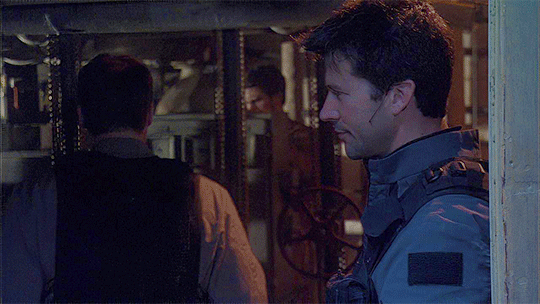
However, it's actually more striking that McKay actually seems to understand John's meaning. Just in the previous episode, Childhood's End (S01E06) McKay seemed unable to understand that when someone asks whether he has chocolate on him, they actually want to have some. That is, he has trouble understanding social cues and interprets things very literally which is on par with fictive representations of geniuses.
This tells us two things: 1) Sheppard has observed McKay enough to be able to anticipate what he's going to do (cf. previous episode for Sheppard keeping a keen eye on everything Rodney does) and 2) McKay must be trying really hard to understand Sheppard, which is something he would not normally bother doing.
Further, Sheppard keeps exhibiting signs of attraction. He seems to sense McKay's movement behind him (physical awareness), his eyes automatically go to him, he aborts the movement once he catches himself but then looks anyway because it would be silly to keep himself from looking at his entirely platonic team member.
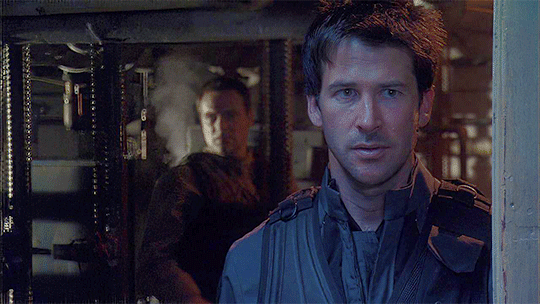

Also, McKay places himself close enough to touch and not only does not John pull away, he pushes back into him (accidentally-on-purpose-touches).
He glances at McKay when he thinks that he's not looking:
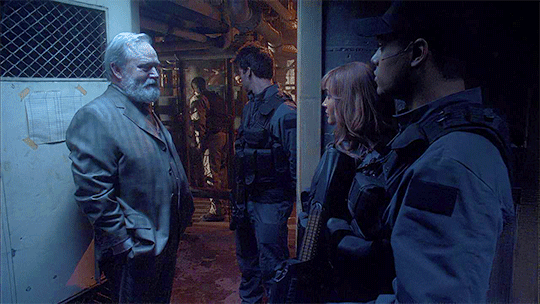
In the episode, we are once more reminded of the importance of looks and subtextual information carried therein with this exchange:
Weir: Major, have you made any progress with your prisoner?
Sheppard: Well, not yet, but he just blinked.
McKay: He blinked? What does that mean?
Sheppard: It means he's still holding on but he's indicated to me that he may break soon.
McKay: And he indicated this to you by ... blinking?
Sheppard: Yes.
The episode also marks the start of Sheppard antagonizing the wraith by giving them human names. He later names Todd after a pale guy a knew in college which makes one wonder if all the names he comes up with are from people of his past. One would venture that he would give the wraith names of people he didn't particularly like but then, there is this strange erotic undertone to his taunting of the wraith. Could the sources of the names be exes or former crushes?
Further, when they're walking side by side, Sheppard actually turns his entire body toward McKay:
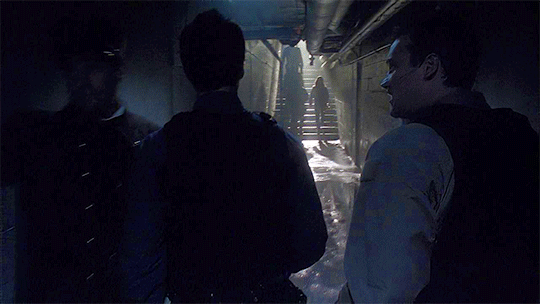
Also, while the licking-his-lip thing seems to be a nervous tick, something that Sheppard does when he's not sure what to say or to deal with some emotion (here, McKay reminds him that he's the one responsible for waking the wraith), he does it twice here in very short order. One of them was wraith-related, the other was purely McKay-related.
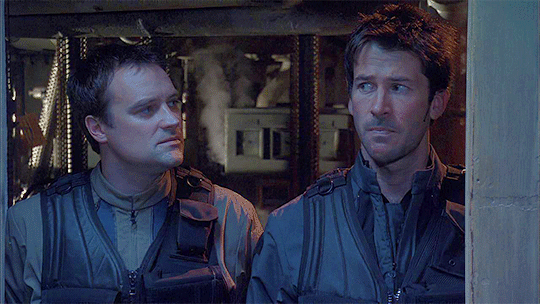
Also notable: John clearly blames himself for waking the wraith, and he could easily have interpreted the look McKay throws at him when the topic comes up as blaming him. But once alone, McKay actually tries to alleviate Sheppard's obvious guilt with "You haven't told them that we practically woke the Wraith from hibernation, have you?"
For a socially inept dude he certainly is able to pass as a human being for this man and this man only.
Also, this exchange:
McKay: Reminds you of Area 51, doesn't it?
Sheppard: Circa 1918.
Ford: I don't think Area 51 was around in 1918, sir.
Sheppard: Well, the area was.
Commenting on a topic that you hope will interest your crush. Teasing reply. Someone else jives in, you do a complete 180 to defend the comment of your would-be boo. This is textbook stuff.
There's innuendo in Sheppard's "Weapons come in all shapes and sizes, lieutenant," especially as it is paired with a shot of a phallic vial being handed to him with a suggestive look from the chancellor with a drawled "Major Sheppard, I think you'll find this intriguing."
Through Sheppard and McKay's discussion with Beckett on the planet, we establish that when someone is not a part of the military, Sheppard can't give them commands. For some reason we, as the audience, really needed to be reminded of that during this time.
This episode also marks the start of several references to Star Trek. It's actually Sheppard that brings it up with "He's worse than McCoy!" completely unprompted, albeit Rodney seems to catch the reference right away. Over the seasons we see further examples of Sheppard revealing what a complete and utter geek he is where McKay just keeps not noticing this fact in spite of their frequent geeky conversations. Also, since Beckett is Bones, and McKay thinks that Sheppard is Kirk, although it is never mentioned, that probably would make McKay Spock. Kirk and Spock being the OG sci-fi television relationship with homoerotic undertones, which were also more or less confirmed by the creators.

According to creator Gene Rodenberry, "I definitely designed it as a love relationship. And I hope that for men… who have been afraid of such relationships… that they [Spock and Kirk] would encourage them to be able to feel love and affection, true affection… love, friendship and deep respect. That was the relationship I tried to draw. I think I also tried to draw a feeling of belief that very few of us are complete unto ourselves. It’s quite a lovely thing… where two halves make a whole."
The introduction of Perna is interesting. When she arrives, Sheppard's gaze first completely slides over her, finding the back of Beckett's head to be more interesting. But a polite fellow, he introduces himself in response to her introduction with a polite smile, then turning to introduce his team and when he's about the introduce McKay, Beckett chimes in, obviously captivated by her.
He's looking at her intensely, starts macking right away. And it's only then that Rodney jumps in with what can only be described as a need to compete with Beckett for the attention of the lady. And John seems pleased as a peach when the Hoffan scientist only seems to have eyes for Beckett.
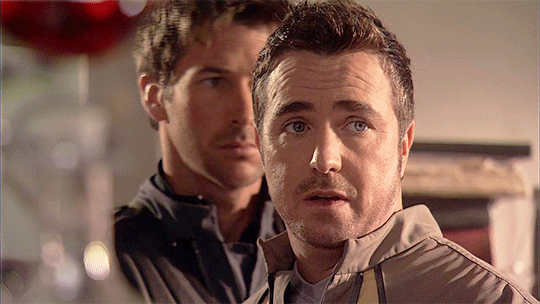
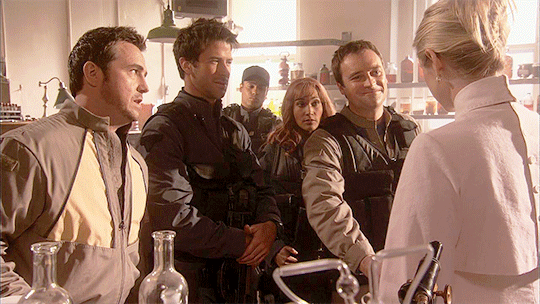
They are in contrast. Sheppard is uninterested. Beckett is immediately and completely taken. McKay's interest is perfunctory. The pretty lady is the trophy of a competition that he just lost.
Perna and Beckett get real close, real fast working side by side together. While this is obvious to the audience, since it is taking place between a man and a woman, the romantic nature of their relationship isn't actually explicitly stated. It is played out through gazes, positioning, intimacy of their rapport. We naturally read this as romance. Everything that takes place between them also takes places between Sheppard and McKay, only spread over several episodes. It's funny how that is.
#stargate atlantis#sga#sga meta#john sheppard#sheppard is bi#rodney mckay#rodney is gay#ep. poisoning the well#ep. childhood's end
37 notes
·
View notes
Text
Movie Musical Divas Tournament: Round 2


Ginger Rogers (1911-1995): Top Hat (1935 - Dale) | 42nd Street (1933 - Annie) | Swing Time (1936 - Penny)
"Best known as Fred Astaire's dance partner, but she was also a skilled comedic and dramatic actress (she won an Oscar in 1940!)." - anonymous
Rita Hayworth (1918-1987): You Were Never Lovelier (1942 v- Maria) | Gilda (1946 - Gilda) | Cover Girl (1944 - Rusty)
"Known as a pin-up girl, Rita was also a very accomplished and gorgeous dancer. Fred Astaire said she was one of the fastest learners he'd ever worked with - extremely high praise!" - anonymous
This is Round 2 of the Movie Musical Divas tournament. Additional polls in this round may be found by searching #mmround2, or by clicking the link below. Add your propaganda and support by reblogging this post.
ADDITIONAL PROPAGANDA AND MEDIA UNDER CUT: ALL POLLS HERE
Ginger Rogers:




youtube
Photo and video submitted by: anonymous | Photos submitted by: @mygreatadventurehasbegun
Rita Hayworth:




youtube
Photos submitted by: @mygreatadventurehasbegun | Video submitted by: anonymous | Photos submitted by: anonymous
26 notes
·
View notes
Text


@shlomo_fishman
One of the main foundations of the Palestinian narrative states that: "according to international law, Israel is occupying Palestinian land".
What most people don't know is that the international law states, in fact, the exact opposite. I'll explain.
In the picture below, you can see article 80 in the UN charter, signed by the UN in 1945 during the San Francisco convention. As stated, its purpose was to ensure the rights given by trusteeship agreements approved by the UN, one of them being the British Mandate which officially began in 1920 and was designated to the establishment of a "national home" for the Jewish people on the area shown in the map below, as previously declared in the Balfour Declaration in 1918.
Now you may say: "but what about the UN general assembly Resolution 181 (the partition plan)?". The answer here is pretty simple: first of all, the general committee has no official power to enforce their decisions, which are mostly symbolic. Second, the plan was never set in motion, as the Arab leadership refused to accept it and the war between the Jewish population and the Arab one, broke down. Regarding the UN security council, Article 24(2) states: "the Security Council shall act in accordance with the Purposes and Principles of the United Nations". Which means it also cannot overrule article 80 in the UN charter.
There is also an argument I heard, about the British Mandate being a class A mandate. Class A mandates, were territories formerly controlled by the Ottoman Empire that were deemed to "... have reached a stage of development where their existence as independent nations can be provisionally recognized subject to the rendering of administrative advice and assistance by a Mandatory until such time as they are able to stand alone. The wishes of these communities must be a principal consideration in the selection of the Mandatory". There is one major problem with this argument: the Muslim Arabs NEVER had any national ambitions back then, nor wanted an independent state until after 1948.
Haj Amin Al-Husseini, probably the most prominent Muslim leader during the British Mandate and the Mufti of Jerusalem at that time, who dedicated his life to combat Zionism and purge the Jewish population in the area, even reaching Adolf Hitler at some point to help him fulfill those plans, never wanted an establishment of an independent Muslim state.
While launching massacres against the Jewish population (the great Arab revolt, 1929 Arab riots and more) and trying to convince Arabs not to sell lands to Jews, he justified it only using religious Islamic motives and blood libels against the Jews. Their only mission was to erase Zionism, so there was never an appeal by him, nor the Arab League and not any other Muslim leadership of that time to the international community, for the establishment of a Muslim state called "Palestine".
So when I define the Palestinians as: "a political movement pretending to be a nation, only to combat Zionism", I talk about this exactly.
This text sums up the main things you should know about the non-existent Israeli occupation, which many people unfortunately don't. So it was very important to me to write about it, especially in these difficult times, and I'd appreciate your support in spreading this message, a lot.
79 notes
·
View notes
Text
Aunty B is an old woman for HER world

So I’d just like to point out to the people saying that Aunty B being 55 doesn’t make her an old lady.
1) while this is an alternative world it’s clearly modeled after early 1900s. The expected average life span for women in 1900 (US) was 48.3 years and in 1917(US) it was 54.0 years. Then in 1918 due to outbreaks like the Spanish Flu it dropped to 39.1 years. (Data from CDC https://www.cdc.gov/nchs/data-visualization/mortality-trends/index.htm). And while these numbers are skewed by high infant mortality rates in the early 1900s the major cause of death for infants regardless of socioeconomics was disease as there were few effective medical treatments(for example penicillin wasn’t discovered until 1928). The other group of people at high risk of death due to illness other then infants are people over the age of 65 so even if people lived to be older then late 40’s or early 50’s one year with a bad influenza such as in 1918 could wipe out a large portion of the older population especially those in poorer socioeconomic positions who lived in the more densely populated but less maintained section of big cities.
2) She’s worked for Candela the longest and while we don’t know exactly how long that’s been it’s clear that working for them for any length of time puts a major toll on a person both mentally and physically. And I’m not sure how many years being in contact with Bleed affects a person but it’s probably compounding. That’s on top of whatever tramatic event she survived that lead her to coming into contact with Candela and Bleed in the first place. We don’t even know how many people are killed in their world each year by Bleed events.
3) Even if she didn’t fight in the war she did live through it and it’s their realms version of WW1 so you know more stress and trauma.
4) she’s clearly been living rough for a while. she may not be homeless but she did say that she has pawned off all her jewelry expect the ones with the most emotional value to her and her job label say that she is a criminal so she’s clearly had it rough outside of her work with Candela.
Point being that comparing and expecting her to be at the same health state to a modern 55 year old woman doesn’t work and so yeah while WE the audience might not view her as being old in her world; especially as a woman who is from the poorer class of society; that has worked with Candela the longest and so has possible had the most contact with Bleed of anyone in the group she would be considered an old woman. Which is why when you look at the official art of the character she looks more like a woman in her late 60’s or early 70’s rather then looking 55 due to the stress and hard life she has led.
130 notes
·
View notes
Text
Lista dei brevetti per la modifica del clima.
Dal 1891 al 2023.
United States Patent and Trademark Office.
...
0462795 – July 16, 1891 – Method Of Producing Rain-Fall
803180 – October 31, 1905 – Means for Producing High Potential Electrical Discharges
1103490 – August 6, 1913 – Rain-Maker
1225521 – September 4, 1915 – Protecting From Poisonous Gas In Warfare
1279823 – September 24, 1918 – Process and Apparatus for Causing Precipitation by Coalescence of Aqueous Particles Contained in the Atmosphere
1284982 – November 19, 1918 – Process and Apparatus for Procuring and Stimulating Rainfall
1338343 – April 27, 1920 – Process And Apparatus For The Production of Intense Artificial Clouds, Fogs, or Mists
1358084 – November 9, 1920 – Method of Producing Fog-Screens
1619183 – March 1, 1927 – Process of Producing Smoke Clouds From Moving Aircraft
1665267 – April 10, 1928 – Process of Producing Artificial Fogs
1892132 – December 27, 1932 – Atomizing Attachment For Airplane Engine Exhausts
1895765 – January 31, 1933 – Artificial Production of Fog
1928963 – October 3, 1933 – Electrical System And Method
1957075 – May 1, 1934 – Airplane Spray Equipment
1993316 – March 5, 1935 – Apparatus for and Method of Producing Oil Fog
2052626 – September 1, 1936 – Method of Dispelling Fog
2097581 – November 2, 1937 – Electric Stream Generator – Referenced in 3990987
2173756 – September 19, 1939 – Process of Producing Fog or Mist by Partial and Flameless Combustion
2352677 – July 4, 1944 – Artificial Fog Production
2476171 – July 18, 1945 – Smoke Screen Generator
2409201 – October 15, 1946 – Smoke Producing Mixture
2480967 – September 6, 1949 – Aerial Discharge Device
2527230 – October 24, 1950 – Method of Crystal Formation and Precipitation
2527231 – October 24, 1950 – Method of Generating Silver Iodide Smoke
2550324 – April 24, 1951 – Process For Controlling Weather
2582678 – June 15, 1952 – Material Disseminating Apparatus For Airplanes
2611992 – September 30, 1952 – Engine Exhaust Operated Fluent Material Distributor
2614083 – October 14, 1952 – Metal Chloride Screening Smoke Mixture
2633455 – March 31, 1953 – Smoke Generator
2688069 – August 31, 1954 – Steam Generator – Referenced in 3990987
2721495 – October 25, 1955 – Method And Apparatus For Detecting Minute Crystal Forming Particles Suspended in a Gaseous Atmosphere
2730402 – January 10, 1956 – Controllable Dispersal Device
2903188 – April 2, 1956 – Control of Tropical Cyclone Formation
2756097 – July 24, 1956 – Process for Weather Control
2801322 – July 30, 1957 – Decomposition Chamber for Monopropellant Fuel – Referenced in 3990987
2835530 – May 20, 1958 – Process for the Condensation of Atmospheric Humidity and Dissolution of Fog
2871344 – January 27, 1959 – Long Distance Communication System
2881335 – April 7, 1959 – Generation of Electrical Fields
2908442 – October 13, 1959 – Method For Dispersing Natural Atmospheric Fogs And Clouds
2962450 – November 29, 1960 – Fog Dispelling Composition
2963975 – December 13, 1960 – Cloud Seeding Carbon Dioxide Bullet
3019989 – February 6, 1962 – Atmospheric Space Charge Modification
2986360 – May 30, 1962 – Aerial Insecticide Dusting Device
3046168 – July 24, 1962 – Chemically Produced Colored Smokes
3056556 – October 2, 1962 – Method of Artificially Influencing the Weather
3126155 – March 24, 1964 – Silver Iodide Cloud Seeding Generator
3127107 – March 31, 1964 – Generation of Ice-Nucleating Crystals
3131131 – April 28, 1964 – Electrostatic Mixing in Microbial Conversions
3140207 – July 7, 1964 – Pyrotechnic Composition
3174150 – March 16, 1965 – Self-Focusing Antenna System
3234357 – February 8, 1966 – Electrically Heated Smoke Producing Device
3274035 – September 20, 1966 – Metallic Composition For Production of Hydroscopic Smoke
3284005 – November 8,1966 – Weather Control by Artificial Means
3300721 – January 24, 1967 – Means For Communication Through a Layer of Ionized Gases
3313487 – April 11, 1967 – Cloud Seeding Apparatus
3338476 – August 29, 1967 – Heating Device For Use With Aerosol Containers
3375148 – March 26, 1968 – Pyrotechnics Comprising Silver Iodate, Ammonium Nitrate, Nitrocellulose and Nitrate Esters
3378201 – April 16, 1968 – Method for Precipitating Atmospheric Water Masses
3410489 – November 12, 1968 – Automatically Adjustable Airfoil Spray System With Pump
3418184 – December 24, 1968 – Smoke Producing Propellant
3429507 – February 25, 1969 – Rainmaker
3432208 – November 7, 1967 – Fluidized Particle Dispenser
3441214 – April 29, 1969 – Method And Apparatus For Seeding Clouds
3445844 – May 20, 1969 – Trapped Electromagnetic Radiation Communications System
3456880 – July 22, 1969 – Method Of Producing Precipitation From The Atmosphere
3518670 – June 30, 1970 – Artificial Ion Cloud
3517512 – June 30, 1970 – Apparatus for Suppressing Contrails
3534906 – October 20, 1970 – Control of Atmospheric Particles
3545677 – December 8, 1970 – Method of Cloud Seeding
3564253 – February 16, 1971 – System And Method For Irradiation Of Planet Surface Areas
3587966 – June 28, 1971 – Freezing Nucleation
3595477 – July 27, 1971 – Fog Dispersing Method and Compositions
3601312 – August 24, 1971 – Methods of Increasing The Likelihood oF Precipitation By The Artificial Introduction Of Sea Water Vapor Into The Atmosphere Winward Of An Air Lift Region
3608810 – September 28, 1971 – Methods of Treating Atmospheric Conditions
3608820– September 20, 1971 – Treatment of Atmospheric Conditions by Intermittent Dispensing of Materials Therein
3613992 – October 19, 1971 – Weather Modification Method
3630950 – December 28, 1971 – Combustible Compositions For Generating Aerosols, Particularly Suitable For Cloud Modification And Weather Control And Aerosolization Process
USRE29142 – May 22, 1973 – Combustible compositions for generating aerosols, particularly suitable for cloud modification and weather control and aerosolization process
3659785 – December 8, 1971 – Weather Modification Utilizing Microencapsulated Material
3666176 – March 3, 1972 – Solar Temperature Inversion Device
3677840 – July 18, 1972 – Pyrotechnics Comprising Oxide of Silver For Weather Modification Use
3690552 – September 12, 1972 – Fog Dispersal
3722183 – March 27, 1973 – Device For Clearing Impurities From The Atmosphere
3748278 – July 24, 1973 – Process and Agents Having an Influence on the Weather
3751913 – August 14, 1973 – Barium Release System
3769107 – October 30, 1973 – Pyrotechnic Composition For Generating Lead Based Smoke
3784099 – January 8, 1974 – Air Pollution Control Method
3785557 – January 15, 1974 – Cloud Seeding System
3788543 – January 29, 1974 – Uniform Size Particle Generator
3795626 – March 5, 1974 – Weather Modification Process
3802971 – April 9, 1974 – Pyrotechnic Formulations for Weather Modification Comprising a Mixture of Iodates
3808595 – April 30, 1974 – Chaff Dispensing System
3813875 – June 4, 1974 – Rocket Having Barium Release System to Create Ion Clouds In The Upper Atmosphere
3835059 – September 10, 1974 – Methods of Generating Ice Nuclei Smoke Particles For Weather Modification And Apparatus Therefore
3835293 – September 10, 1974 – Electrical Heating Apparatus For Generating Super Heated Vapors
3858805 – January 7, 1975 – Ice Nucleation by Micas
3877642 – April 15, 1975 – Freezing Nucleant
3882393 – May 6, 1975 – Communications System Utilizing Modulation of The Characteristic Polarization of The Ionosphere
3887580 – June 3, 1975 – Method of Crystallization of Water in Supercooled Clouds and Fogs and Reagent Useful in Said Method
3896993 – July 29, 1975 – Process For Local Modification of Fog And Clouds For Triggering Their Precipitation And For Hindering The Development of Hail Producing Clouds
3899129 – August 12, 1975 – Apparatus for generating ice nuclei smoke particles for weather modification
3899144 – August 12, 1975 – Powder contrail generation
3915379 – October 28, 1975 – Method of Controlling Weather
3940059 – February 24, 1976 – Method For Fog Dispersion
3940060 – February 24, 1976 – Vortex Ring Generator
3990987 – November 9, 1976 – Smoke generator
3992628 – November 16, 1976 – Countermeasure system for laser radiation
3994437 – November 30, 1976 – Broadcast dissemination of trace quantities of biologically active chemicals
4042196 – August 16, 1977 – Method and apparatus for triggering a substantial change in earth characteristics and measuring earth changes
RE29,142 – February 22, 1977 – Combustible compositions for generating aerosols, particularly suitable for cloud modification and weather control and aerosolization process
4009828 – March 1 1977 – Organic Nucleating Agent for both Warm and Cold Clouds
4035726 – July 12, 1977 – Method of controlling and/or improving high-latitude and other communications or radio wave surveillance systems by partial control of radio wave et al
4096005 – June 20, 1978 – Pyrotechnic Cloud Seeding Composition
4129252 – December 12, 1978 – Method and apparatus for production of seeding materials
4141274 – February 27, 1979 – Weather modification automatic cartridge dispenser
4167008 – September 4, 1979 – Fluid bed chaff dispenser
4347284 – August 31, 1982 – White cover sheet material capable of reflecting ultraviolet rays
4362271 – December 7, 1982 – Procedure for the artificial modification of atmospheric precipitation as well as compounds with a dimethyl sulfoxide base for use in carrying out said procedure
4373391 – February 15, 1983 – Relative Humidity Sensitive Material
4396152 – August 2, 1983 – Aerosol Dispenser System
4402480 – September 6, 1983 – Atmosphere modification satellite
4412654 – November 1, 1983 – Laminar microjet atomizer and method of aerial spraying of liquids
4415265 – November 15, 1983 – Method and apparatus for aerosol particle absorption spectroscopy
4470544 – September 11, 1984 – Method of and Means for weather modification
4475927 – October 9, 1984 – Bipolar Fog Abatement System
4600147 – July 15, 1986 – Liquid propane generator for cloud seeding apparatus
4633714 – January 6, 1987 – Aerosol particle charge and size analyzer
4643355 – February 17, 1987 – Method and apparatus for modification of climatic conditions
4653690 – March 31, 1987 – Method of producing cumulus clouds
4684063 – August 4, 1987 – Particulates generation and removal
4686605 – August 11, 1987 – HAARP Patent / EASTLUND PATENT – Method and apparatus for altering a region in the earth’s atmosphere, ionosphere, and/or magnetosphere
4704942 – November 10, 1987 – Charged Aerosol
4712155 – December 8, 1987 – Method and apparatus for creating an artificial electron cyclotron heating region of plasma
4742958 – May 10, 1988 – Method for Making Artificial Snow
4744919 – May 17, 1988 – Method of dispersing particulate aerosol tracer
4766725 – August 30, 1988 – Method of suppressing formation of contrails and solution therefor
4829838 – May 16, 1989 – Method and apparatus for the measurement of the size of particles entrained in a gas
4836086 – June 6, 1989 – Apparatus and method for the mixing and diffusion of warm and cold air for dissolving fog
4873928 – October 17, 1989 – Nuclear-sized explosions without radiation
4948257 – August 14, 1990 – Laser optical measuring device and method for stabilizing fringe pattern spacing
1338343– August 14, 1990 – Process and Apparatus for the production of intense artificial Fog
4999637 – March 12, 1991 – Creation of artificial ionization clouds above the earth
5003186 – March 26, 1991 – Stratospheric Welsbach seeding for reduction of global warming
5005355 – April 9, 1991 – Method of suppressing formation of contrails and solution therefor
5038664 – August 13, 1991 – Method for producing a shell of relativistic particles at an altitude above the earths surface
5041760 – August 20, 1991 – Method and apparatus for generating and utilizing a compound plasma configuration
5041834 – August 20, 1991 – Artificial ionospheric mirror composed of a plasma layer which can be tilted
5056357 – October 15, 1991- Acoustic method for measuring properties of a mobile medium
5059909 – October 22, 1991 – Determination of particle size and electrical charge
5104069 – April 14, 1992 – Apparatus and method for ejecting matter from an aircraft
5110502 – May 5, 1992 – Method of suppressing formation of contrails and solution therefor
5156802 – October 20, 1992 – Inspection of fuel particles with acoustics
5174498 – December 29, 1992 – Cloud Seeding
5148173 – September 15, 1992 – Millimeter wave screening cloud and method
5242820 – September 7, 1993 – Army Mycoplasma Patent Patent
5245290 – September 14, 1993 – Device for determining the size and charge of colloidal particles by measuring electroacoustic effect
5286979 – February 15, 1994 – Process for absorbing ultraviolet radiation using dispersed melanin
5296910 – March 22, 1994 – Method and apparatus for particle analysis
5327222 – July 5, 1994 – Displacement information detecting apparatus
5357865 – October 25, 1994 – Method of cloud seeding
5360162 – November 1, 1994 – Method and composition for precipitation of atmospheric water
5383024 – January 17, 1995 – Optical wet steam monitor
5425413 – June 20, 1995 – Method to hinder the formation and to break-up overhead atmospheric inversions, enhance ground level air circulation and improve urban air quality
5434667 – July 18, 1995 – Characterization of particles by modulated dynamic light scattering
5436039 – July 25, 1995 – Artificial Snow in an Aggregate Form of Snow Granules
5441200 – August 15, 1995 – Tropical cyclone disruption
5492274 – February 20, 1996 – Method of and Means for Weather Modification
5546183 – August, 13, 1996 – LIDAR Droplet Size Monitor for In-Flight Measurement of Aircraft Engine Exhaust Contrails, Droplets and Aerosols
5556029 – September 17, 1996 – Method of hydrometeor dissipation (clouds)
5628455 – May 13, 1997 – Method and apparatus for modification of supercooled fog
5631414 – May 20, 1997 – Method and device for remote diagnostics of ocean-atmosphere system state
5639441 – June 17, 1997 – Methods for fine particle formation
5762298 – June 9, 1998 – Use of artificial satellites in earth orbits adaptively to modify the effect that solar radiation would otherwise have on earth’s weather
5800481 – September 1, 1998 – Thermal excitation of sensory resonances
5912396 – June 15, 1999 – System and method for remediation of selected atmospheric conditions
5922976 – July 13, 1999 – Method of measuring aerosol particles using automated mobility-classified aerosol detector
5949001 – September 7, 1999 – Method for aerodynamic particle size analysis
5984239 – November 16, 1999 – Weather modification by artificial satellites
6025402 – February 15, 2000 – Chemical composition for effectuating a reduction of visibility obscuration, and a detoxifixation of fumes and chemical fogs in spaces of fire origin
6030506 – February 29, 2000 – Preparation of independently generated highly reactive chemical species
6034073 – March 7, 2000 – Solvent detergent emulsions having antiviral activity
6045089 – April 4, 2000 – Solar-powered airplane
6056203 – May 2, 2000 – Method and apparatus for modifying supercooled clouds
6315213B1 – June 21, 2000 – Method of modifying weather
6110590 – August 29, 2000 – Synthetically spun silk nanofibers and a process for making the same
6263744 – July 24, 2001 – Automated mobility-classified-aerosol detector
6281972 – August 28, 2001 – Method and apparatus for measuring particle-size distribution
20030085296 – November 2, 2001 – Hurricane and tornado control device
6315213 – November 13, 2001 – Method of modifying weather
2002009338 – January 24, 2002 – Influencing Weather Patterns by way of Altering Surface or Subsurface Ocean Water Temperatures
20020008155 – January 24, 2002 – Method and System for Hurricane Control
6382526 – May 7, 2002 – Process and apparatus for the production of nanofibers
6408704 – June 25, 2002 – Aerodynamic particle size analysis method and apparatus
6412416 – July 2, 2002 – Propellant-based aerosol generation devices and method
6520425 – February 18, 2003 – Process and apparatus for the production of nanofibers
6539812 – April 1, 2003 – System for measuring the flow-rate of a gas by means of ultrasound
6553849 – April 29, 2003 – Electrodynamic particle size analyzer
6569393 – May 27, 2003 – Method And Device For Cleaning The Atmosphere
20040060994 – April 1, 2004 – Method for Influencing Atmospheric Formations
20040074980 – April 22, 2004 – Method and Device for Generating a Liquid Mist
0056705 A1 – March 17, 2005 – Weather Modification by Royal Rainmaking Technology
6890497 – May 10, 2005 – Method For Extracting And Sequestering Carbon Dioxide
2446250 – January 4, 2007 – A dust or particle-based solar shield to counteract global warming
20070056436 – March 15, 2007 – Challenger to Natural Twisters, Technology
2007033448 – March 29, 2007 – Production of Localized Artificial Rains in Polar Stratospheric Clouds, to Promote a Rain Wash in the CIO Gas, Reduce the Destruction of the Ozone Layer and a Replacement Process in situ of the Stratospheric Ozone
20070114298 – May 24, 2007 – Hurricane Abatement Method and System
20070158449 – July 12, 2007- Tropical Hurricane Control System
20070215946 – September 20, 2007 – Broadband Communications System via Reflection from Artificial Ionized Plasma Patterns in the Atmosphere
7965488 – November 9, 2007 – Methods Of Removing Aerosols From The Atmosphere
8048309 – August 28, 2008 – Seawater-Based Carbon Dioxide Disposal
20080203328 – August 28, 2008 – Outer Space Sun Screen for Reducing Global Warming
20100072297 – September 24, 2008 – Method for controlling hurricanes
7434524 – October 14, 2008 – Machine to Get Rid of Hurricanes
8012453 – October 27, 2008 – Carbon Sequestration And Production Of Hydrogen And Hydride
20090008468 – January 8, 2009 – How to Tame Hurricanes and Typhoons with Available Technology
7520237 – April 21, 2009 – Hurricane Prevention System and Method
20090255999 – October 15, 2009 – Production or Distribution of Radiative Forcing Elements
20090290761 – November 26, 2009 – Upper Troposphere and Lower Stratosphere Wind Direction, Speed, and Turbidity Monitoring using Digital Imaging and Motion Tracking
7645326 – January 12, 2010 – RFID environmental manipulation
7655193 – February 2, 2010 – Apparatus For Extracting And Sequestering Carbon Dioxide
20100074390 – March 25, 2010 – Method for Weather Modification and Vapor Generator for Weather Modification
20100127224 – May 27, 2010 – Atmospheric Injection of Reflective Aerosol for Mitigating Global Warming
7748662 – July 6, 2010 – Aerial Delivery System
20100170958 – July 8, 2010 – Hurricane Mitigation by Combined Seeding with Condensation and Freezing Nuclei
20100252648 – October 7, 2010 – Climate Processor
20100264230 – October 21, 2010 – Severe Storm / Hurricane Modification Method and Apparatus
20100282914 – November 11, 2010 – Enhanced Aerial Delivery System
20110005422 – January 13, 2011 – Method and Apparatus for Cooling a Planet
20110049257 – March 3, 2011 – Method and Apparatus for Local Modification of Atmosphere
20110101124 – May 5, 2011- Hurricane Abatement System and Method
2011073650 – June 23, 2011 – Atmospheric Delivery System
20110168797 – July 14, 2011 – Method of Weakening a Hurricane
20110174892 – July 21, 2011 – Apparatus and Related Methods for Weather Modification by Electrical Processes in the Atmosphere
20110198407 – August 18, 2011 – Method and Apparatus to Break Up or Annihilate Typhoons, Tornadoes, Cyclones or Hurricanes
20110204159 – August 25, 2011 – Weather Management Using Space-Based Power System
20110284649 – November 24, 2011 – Apparatus and Method for the Mitigation of Rotating Wind Storms
8079545 – December 20, 2011 – Ground based Manipulation and Control of Aerial Vehicle during nonflying operations
20120024971 – February 2, 2012 – Methods for Environmental Modification with Climate Control Materials and Coverings
8262314 – September 11, 2012 – Method for Decreasing the Intensity and Frequency of Tropical Storms or Hurricanes
0117003 – October 5, 2012 – Geoengineering Method Of Business Using Carbon Counterbalance Credits
20120267444 – October 25, 2012- Artificial Freezing Apparatus and Freezing Method Therefor
20120286096 – November 15, 2012 – Aerial Delivery Devices, Systems and Methods
20130008365 – January 10, 2013 – System and Method for Decreasing the Intensity and Frequency of Tropical Storms or Hurricanes
20130015260 – January 17, 2013 – Concept and Model for Utilizing High-Frequency or Radar or Microwave Producing or Emitting Devices to Produce, Effect, Create or Induce Lightning or Lightspeed or Visible to Naked Eye Electromagnetic Pulse or Pulses, Acoustic or Ultrasonic Shockwaves or Booms in the Air, Space, Enclosed, or Upon any Object or Mass, to be Used Solely or as Part of a System, Platform or Device Including Weaponry and Weather Modification
8373962 – February 12, 2013 – Charged seed cloud as a method for increasing particle collisions and for scavenging airborne biological agents and other contaminants
20130038063 – February 14, 2013 – Apparatus and Method for Inhibiting the Formation of Tropical Cyclones
201300043322 – February 21, 2013 – Processes and Apparatus for Reducing the Intensity of Tropical Cyclones
8402736 – March 26, 2013 – Method and Apparatus for Suppressing Aeroengine Contrails
8439278 – May 14, 2013 – Apparatus for Producing a Mass of Water Vapor, Apparatus for Producing, Moving, and Climbing a Mass of Water Vapor, and Method of Causing Artificial Stimulation of Rain
20130175352 – July 11, 2013 – Method to Influence the Direction of Travel of Hurricanes
20130186127 – July 25, 2013 – Ice Floater for Facilitating Ice-Freezing on Water Surface
20130206912 – August 15, 2013 – Moisture Dispersion
20140055876 – February 27, 2014 – Method for Controlling Land Surface Temperature using Stratospheric Airships and Reflector
20140131471 – May 15, 2014 – Apparatus to Channel Large Air Masses for Climate Modification
20140145002 – May 29, 2014 – System for Facilitating Cloud Formation and Cloud Precipitation
20140224894 – August 14, 2014 – Technique to Mitigate Storms using Arrays of Wind Turbines
8825241 – September 2, 2014 – Autonomous Wave-Powered substance Distribution Vessels for Fertilizing Plankton, Feeding Fish, and Sequestering Carbon from the Atmosphere
8944363 – February 3, 2015 – Production or Distribution of Radiative Forcing Agents
20150077737 – March 19 2015 – System and Methods for Monitoring an Environment
9002660 – April 7, 2015 – Device and Method for Determining and Indicating Climate-Relevant Effects of a Contrail Produced by an Airplane
20150230415 – August 20, 2015 – Methods for Decreasing Local Temperature using High Albedo Materials
20150337224 – November 26, 2015 – Microwave Acceleration of Carbon Gasification Reactions
9311539 – April 12, 2016 – Aircraft Contrail Detection
9429348 – August 30, 2016 – Method and Device for Producing Snow
9491911 – November 15, 2016 – Method for Modifying Environmental Conditions with Ring Comprised of Magnetic Material
9589473 – March 7, 2017 – Method and System for Automatically Displaying Flight Path, Seeding Path, and Weather Data
9715039 – July 25, 2017 – Apparatus and System for Smart Seeding within Cloud Formations
20170217587 – August 3, 2017 – Vehicles and Systems for Weather Modification
20170303479 – October 26, 2017 – Warm Cloud Catalyst, Preparation Method Therefor and Application Thereof
20180006422 – January 4, 2018 – Methods for Disrupting Hurricane Activity
20180006421 – January 4, 2018 – Methods for Disrupting Tornadic Activity
9924640 – March 27, 2018 – Modifying Sunlight Scatter in the Upper Atmosphere
20180217119 – August 2, 2018 – Process and Method for the Enhancement of Sequestering Atmospheric Carbon through Ocean Iron Fertilization, and Method for Calculating net Carbon Capture from said Process and Method
10189753 – January 29, 2019 – Fog-Generating Device Comprising a Reagent and Ignition Means
2019203461 – June 6, 2019 – Airships for Weather Manipulation
10314249 – June 11, 2019 – Systems and Methods of Inducing Rainfall
10375900 – August 13, 2019 – Rain Induced by Supercontinuum Laser Beams
10433408 – October 1, 2019 – Methods for Affecting Spinning Atmospheric Phenomena
10435165 – October 8, 2019 – Aircraft Electrically-Assisted Propulsion Control System
20190364748 – December 5, 2019 – Method and System for Expressing Airborne Cloud Seeding Line Considering Cloud Water
20200187430 – June 18, 2020 – Helical Artificial Generator of Tornado, Hurricane, Yellow Dust, and Typhoon
20200196539 – June 25, 2020 – Device for Seeding a Cloud Cell
10701871 – July 7, 2020 – Systems for Maintaining and/or Decreasing Water Temperature using High Albedo Materials
20200233115 – July 23, 2020 – Method and System for Determining Cloud Seeding Potential
WO2020148644A1 – July 23, 2020 – 3d Reduced Graphene Oxide/Sio 2 Composite for Ice Nucleation
20200261939 – August 20, 2020 – Apparatus for Generating and Optically Characterizing an Aerosol
2020101897 – September 9, 2020 – Artificial Rainmaking by High Power Laser Initiation Endothermic Reactions through Drone Aircraft Remote Control System
20200288650 – September 17, 2020 – Technology and Technique to Prevent, Diminish or Interfere with the Formation of Hurricanes on Earth from one or more Platforms in Space
20200288651 – September 17, 2020 – Methods for Cooling Water Temperature using High Albedo Materials
20200315104 – October 8, 2020 – Propagating Sound Through Bodies of Water, to Generate and Direct Wind, for the Purpose of Moderating and Affecting Weather Patterns
20200386970 – December 10, 2020 – Aerostatically Stabilized Atmospheric Reflector to Reduce Solar Irradiance
10888051 – January 12, 2021 – Intelligent Systems for Weather Modification Programs
20210037719 – February 11, 2021 – Planetary Weather Modification System
10941705 – March 9, 2021 – Hanson-Haber Aircraft Engine for the Production of Stratospheric Compounds and for the Creation of Atmospheric Reflectivity of Solar Radiation in the 555nm Range and to Increase Jet Engine Thrust and Fuel Economy through the Combustion of Ammonia and Ammonia By-Products
2021063943 – April 8, 2021 – Bacterial Preparations for Ice Nucleation
20210153442 – May 27, 2021 – Systems and Methods for Rain Cloud Initiation
20210163157 – June 3, 2021 – Artificial Ring, Solenoid System to Terraform
20210235638 – August 5, 2021 – Weather Management of Cyclonic Events
2021152336 – August 8, 2021 – Method of Cloud Seeding using Natural Ice Nucleating Agents
20210285851 – September 16, 2021- System for Sampling and Analyzing Contrails Generated by an Aircraft
20210289720 – September 23, 2021 – Systems and Methods for Producing Rain Clouds
2021105881 – October 21, 2021 – Process for Generating Marine Clouds and Ocean Microbubbles
20210329922 – October 28, 2021 – Compositions and Methods for Enhanced CO2 Capture and Storage
20210329852 – October 28, 2021 – Method for Preventing a Formation of, and/or for Dispersing, a Tropical Cyclone, and Arrangement Therefor
20210352856 – November 18, 2021 – Aerial Electrostatic System for Weather Modification
2021107294 – December 9, 2021 – Wind Turbines for Marine Cloud Brightening Dispersion
2022003028 – January 6, 2022 – Apparatus for Precipitation of Atmospheric Water
23220065599 – March 3, 2022 – Rocket for Artificial Rainfall using Ejection Hygroscopic Flare
11274534 – March 15, 2022 – Artificial rain to support water flooding in remote oil fields
20220113450 – April 14, 2022 – Calculation Method of Total Artificial Precipitation in Seeding Area Compared to Non-Seeding Area
2022094269 – May 5, 2022 – Reflective Hollow SRM Material and Methods
3994976 – May 11, 2022 – Apparatus for Electro-Spray Cloud Seeding
11330768 – May 17, 2022 – Systems and Methods for Producing Rain Clouds
20220268505 – August 25, 2022 – Method and Apparatus for Making Falling Snow
2022186970 – September 9, 2022 – Method of Geoengineering to Reduce Solar Radiation
20220355925 – November 10, 2022 – Aeronautical Car and Associated Features
20220357482 – November 10, 2022 – Method and System of Analyzing Ingredients of Artificial Rainfall for Verification of Cloud Seeding Effect
20230050373 – February 16, 2023 – Electromagnetic System to Modify Weather
20230075132 – March 9, 2023 – System for Moderating Energy Absorption at the Earth’s Surface with a Programmable Forcing Network of Climate Control Panels
20230117390 – April 20, 2023 – System and Method for Proactive and Reversible Mitigation of Storm/Hurricane/Typhoon/Cyclone
20230126982 – April 27, 2023 – Method for Analyzing Effect of Hygroscopic Seeding Material Sprayed on Ground Aerosol Concentration Through Airborne Cloud Seeding Experiment
20230141493 – May 11, 2023 – Device for Unmanned Aerial Vehicle to Deploy a Rainfall Catalytic Bomb
20230149876 – May 18, 2023 – Coated Chloride Salt Particles and Methods of Making and Using the Same.
38 notes
·
View notes
Note
can you maybe tell us about the history of trans healthcare? I'm writing a trans character in an old west setting and don't know exactly what would be available to her
So this is a really cool question.
There have been (what we would today call) transgender and gender-non-conforming people as far back as we have records that can describe them. Depending on where in the world a person was and what culture they belonged to, being trans or gender-non-conforming may have been something lived openly, or it may have been something more hidden.
This makes it difficult to cover all of trans history in one tumblr post, so I'll focus on 2 things- trans history during the western expansion (the time between 1803 and 1893 across what is now the western USA, often referred to as the "old west" "wild west" or "frontier"), and trans healthcare access as it is recorded in the USA.
So first let's talk a little about trans people on the frontier.

[Trans Woman of the Frontier: Mrs. Nash]
Simply put, there were a lot of them. Or, at least, there were a lot more of them living on the frontier than there were on the east coast. Many accounts tend to be of what we today would call trans men. Earlier, historians often brushed their existence off as a practicality- If a woman wanted a decent-paying job on the range, of course they would change their name, wear men's clothing, and act as a man.
But this doesn't explain the fact that many of them lived their personal lives as men too, often taking wives and continuing to live lives as men even after being arrested multiple times for cross dressing, or after the conclusion of their career. Look up "Harry Allen" if you want a real man's man on the frontier.
In fact, today one of the reasons historians think there were more trans people out west was because news of these arrests often made it back to the east coast. Closeted trans people reading these (often sensationalized) stories were essentially promised a life and future on the frontier with people like them- a life and future they could move and restart easily if they happened to be, you know, arrested for transness.
It also doesn't explain the trans women. While there are fewer records of trans women on the frontier, they did exist. And since women could typically hide more easily assuming they had an understanding husband (or beard), that kind of makes sense. Look up "Mrs. Nash" who worked as a laundress and took 3 husbands over her lifetime. She was only outed as trans upon her death.
Long story short, it would be very historically accurate to have a trans person on the frontier, and while it might have been reasonable to assume they could make a life there, officially transness wasn't particularly well accepted by the establishment.
Trans healthcare on the frontier was unfortunately not really a thing beyond what today we would call social transition- the adoption of new clothing, a new name, and new speech patterns.
This was because the first medical transition care wouldn't occur until 1918 in Germany and wouldn't move to the US until the 1940s, half a century after the frontier was declared closed.
In 1922 the first successful gender-affirming surgery was performed. It was an orchiectomy (removal of the testes) on a woman named Dora Richter in Germany.
In 1931 Dora completed her transition with several more successful surgeries. This was also the year Lili Elbe (of The Danish Girl fame) passed away from infection related to a gender affirming surgery (why did they decide to tell her story instead of Dora's?? Dora literally worked in trans healthcare for most of her career??).
Anyway. In the 1940's Dr. Alfred Kinsey began his study of human sexuality and gender in Indiana, USA. He was the first person to use the term "transsexual", which gave a name to the experience of someone who's gender did not align with their sex assigned at birth.
Hormone therapy in the US was introduced by Dr. Henry Benjamin sometime in the 1950s, along with the first US citizens travelling to Europe to complete gender affirming surgeries. Dr. Benjamin published the first papers on hormone therapy in 1967, prompting the openings of about 40 "gender clinics" throughout the US. Unfortunately, many of these clinics provided gender-affirming care in name only- the larger ones (like the Johns Hopkins Gender Identity Clinic) getting over 100 applications per year for surgical interventions, but providing only about 5-7 per year after a rigorous process of proving one's transgender status.
By the late 1960's and early 1970's, many US trans people were choosing to circumvent the larger medical centers and either going abroad or using smaller specialty clinics that could do surgeries more discreetly and were less interested in the research value of trans people.
In 1979, many of the larger gender clinics shut down after a paper (with very poor methodology) stated that trans people were no better off mentally after transition. This, though awful, sparked Dr. Benjamin to start the organization that would become the World Professional Association for Transgender Health, which publishes the standards by which gender affirming patients are treated today.
After this point, clinics slowly rebuilt. From a low of 2-3 in the mid 1990s to hundreds of clinics open today. The Johns Hopkins' clinic reopened in 2016.
R E F E R E N C E S
#transgender#LGBTQ#history#westerns#wild west#writing reference#whump reference#hospital life#trans#healthcare
75 notes
·
View notes
Text

A NEW DAY
In this week’s Torah portion, “Va’etchanan” ("I entreated”), Moses continues his “recap" of the Torah, describing in his own words the Exodus and the revelation at Mount Sinai. He implores the Israelites to follow God’s laws and treasure the Torah, and “you shall not add anything to what I command you or take anything away from it….” (Deut. 4:2) Va’etchanan contains a repetition of the Ten Commandments and the Shema, the essential statement of Jewish monotheism: “Hear O Israel: the Lord is our God, the Lord is one.” The Shema commands us to love God with all our heart, our soul, and our might, and continues, “And these words I command you today shall be upon your heart.” (Deut. 6:6)
The Torah is famously terse, with not a single extraneous word (or letter.) Why is it necessary to say “today” I command you? Wouldn’t the verse’s meaning be the same if it simply said “And these words I command you shall be…”? According to medieval commentator Rashi (1040-1105), “today” means that we should not see the commandments as antiquated royal edicts that nobody pays attention to anymore. Rather we should consider God’s laws to be newly-given and exciting, the kind of words that a person would run to hear.
Rav Chaim of Brisk (1853-1918) explains that a person’s situation and responsibilities vary from day to day. Our mission today is not the same as yesterday’s or tomorrow’s. We must begin each day anew, reflecting on our current position and and asking God, “What is my mission today?”
May we serve the Holy One with renewed enthusiasm each and every day!
Image: Shema inscription on the Knesset Menorah in Jerusalem
19 notes
·
View notes
Photo

The territorial history of Armenia and Azerbaijan
“Atlas of the Ethno-Political History of the Caucasus”, Arthur Tsutsiev, Yale University Press, 2014
The Armenian historical view centers on the global threat associated with the expansion of Turkic-speaking tribal groups into former Armenian territories, including Artsakh (Karabakh). Today's Azerbaijan is itself largely the former Caucasian Albania, a land which became Christian in the middle of the 4th century, submerged from the 11th century by Turkish invasions and which, in the 19th century, completely disappeared, transformed into a territory Turkish and Muslim.
Azerbaijan comes from the Democratic Republic of Azerbaijan of 1918-1920, created following Turkish intervention and taking its name from a Persian region located further south. This part of Eastern Transcaucasia, incorporated into Russia between 1803 and 1828, is in fact a former Persian territory with an indigenous sedentary Armenian population and a nomadic Turkish-Kurdish population who arrived later.
After the First World War, the Armenians would not have a state in the former Ottoman territories but a small formerly Russian territory around the city of Yerevan, southwestern part of the Transcaucasian Federative Democratic Republic (April -May 1918) which takes the name of the Democratic Republic of Armenia. From June 1920, the Kemalist Turkish nationalists began negotiations with the Soviets and the demarcation of the borders of the Armenian Soviet Socialist Republic (born December 2) was ultimately to the detriment of the Armenians themselves, since it did not does not include Karabakh, included entirely in Azerbaijan, at the insistent request of the Turks.
From then on, the Armenians are a people who have the particularity of being deprived of a large part of their historical territory even though it dates back to the 9th century BC with the kingdom of Urartu and its territorial peak dates from the end of the 2nd century BC when King Tigranes dominated a territory stretching from the Caspian to the Mediterranean.
by cartesdhistoire
146 notes
·
View notes